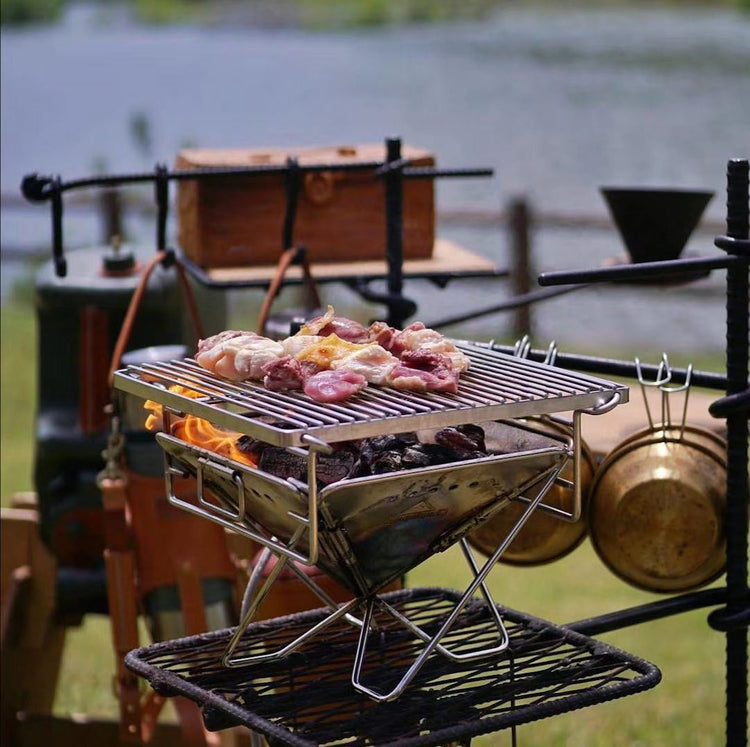The crackling warmth and mesmerizing dance of a campfire are deeply ingrained in the human experience, especially during outdoor adventures. However, our love for this primal tradition must be balanced with a responsibility to protect the natural environments we cherish.
"Compare traditional campfire smoke to a cleaner-burning eco-friendly campfire."
1. The Problem with Traditional Firewood: Understanding the Impact
Before diving into solutions, it's crucial to understand the environmental consequences of unsustainable firewood practices:
- Deforestation and Habitat Loss: Harvesting firewood indiscriminately can lead to deforestation, destroying vital habitats for wildlife and contributing to soil erosion.
- Transportation of Invasive Species: Moving firewood across long distances can introduce harmful invasive insects and diseases that can devastate local ecosystems.
- Air Pollution: Burning wood releases particulate matter and other pollutants into the air, impacting air quality and potentially human health.
- Scarring the Landscape: Improper campfire building can leave lasting burn scars on the ground, hindering vegetation regrowth and altering soil composition.
"Unsustainable firewood harvesting can lead to deforestation and introduce invasive species."
2. Choosing Sustainable Firewood: Fueling Your Fire Responsibly
The foundation of an ethical firewood practice lies in making informed choices about your fuel source:
Source it Locally (Within 50 Miles)
This is the golden rule. Buying or collecting firewood within a 50-mile radius of your campsite significantly reduces the risk of transporting invasive species. Look for certified local firewood vendors.
Look for Certified Sustainable Sources
Some firewood suppliers offer wood harvested from sustainably managed forests. Look for certifications from organizations promoting responsible forestry.
Gather Responsibly (Where Permitted)
In some areas, you may be allowed to gather dead and down wood. Follow these guidelines strictly:
- Know the Regulations: Always check local regulations and obtain permits if required.
- Collect Sparingly: Take only what you need for your immediate use.
- Focus on Small, Dry Wood: Dead and down branches and twigs burn more efficiently and produce less smoke than large logs.
- Leave No Trace: Avoid stripping bark from living or dead trees.
Consider Alternatives
For shorter trips or in areas with strict fire regulations, explore alternatives like portable propane fire pits, which offer a flame without the need for wood.
"Sourcing firewood locally is a key step towards a green campfire."
3. Responsible Burning Practices: Minimizing Your Campfire's Impact
Even with renewable firewood, how you build and manage your fire significantly impacts the environment:
- Build Small Fires: Resist the urge to build a massive bonfire. A small, contained fire provides sufficient warmth and light while consuming less fuel and producing less smoke.
- Use Existing Fire Rings or Build a Mound Fire: Utilize established fire rings whenever possible. If no fire ring exists, create a mound fire on mineral soil.
- Keep Fires Contained: Never let your fire spread beyond the designated area. Clear a 10-foot radius around your fire pit.
- Burn Wood Completely to Ash: Ensure all wood is burned down to fine ash to minimize leftover debris.
- Minimize Smoke: Use dry, seasoned firewood and arrange wood loosely for good airflow.
- Never Burn Trash: Burning waste releases harmful toxins into the air.
- Be Aware of Wind Conditions: Avoid building fires in strong winds.
- Extinguish Fires Thoroughly: Douse with water, stir the ashes, and feel for any remaining heat.
"Learn how to build a responsible mound fire using Leave No Trace principles."
4. Leave No Trace Principles and Campfires: A Guiding Ethos
The Leave No Trace principles provide a framework for minimizing our impact in the outdoors:
- Plan Ahead and Prepare: Know the fire regulations for your destination.
- Travel and Camp on Durable Surfaces: Use existing fire rings or mineral soil for fires.
- Dispose of Waste Properly: Pack out all trash, including any unburned materials.
- Leave What You Find: Do not collect excessive amounts of firewood.
- Minimize Campfire Impacts: Build small fires, burn wood completely, and extinguish thoroughly.
- Respect Wildlife: Avoid building fires near animal trails or sensitive habitats.
"The Leave No Trace principles guide responsible outdoor practices, including campfires."
5. The Future of Campfires: Innovation and Alternatives
As awareness of environmental impact grows, so does the innovation in campfire alternatives:
- Portable Propane Fire Pits: Offer instant flame with adjustable heat and no wood consumption or ash.
- Battery-Powered "Campfire" Lanterns: Provide ambiance and light without any fire or emissions.
- Efficient Wood-Burning Stoves: For cooking, these stoves use significantly less wood and produce less smoke than open fires.
While these alternatives may not fully replicate the traditional campfire experience, they offer viable options for those seeking to minimize their environmental impact.
"Explore eco-friendly alternatives to traditional campfires."
Conclusion: Enjoy the Warmth, Protect the Wild
Enjoying the warmth and camaraderie of a campfire doesn't have to come at the expense of our natural world. By choosing sustainable firewood, practicing responsible burning, and embracing the principles of Leave No Trace, we can continue this cherished tradition while minimizing our impact. Let's strive to build ethical fires, leaving our campsites clean and our ecosystems healthy for generations to come.






